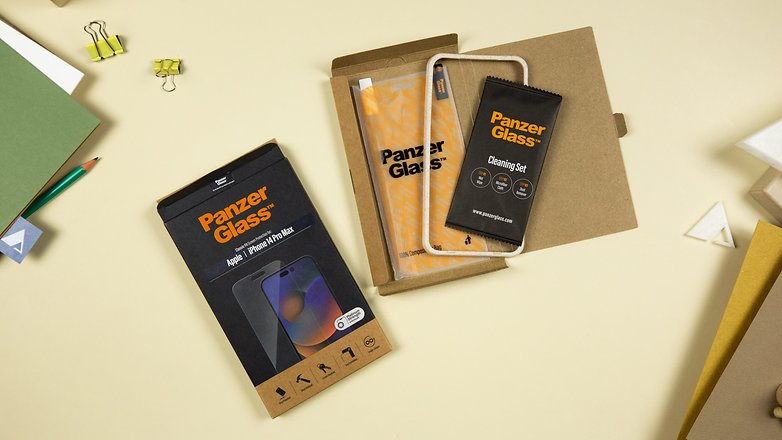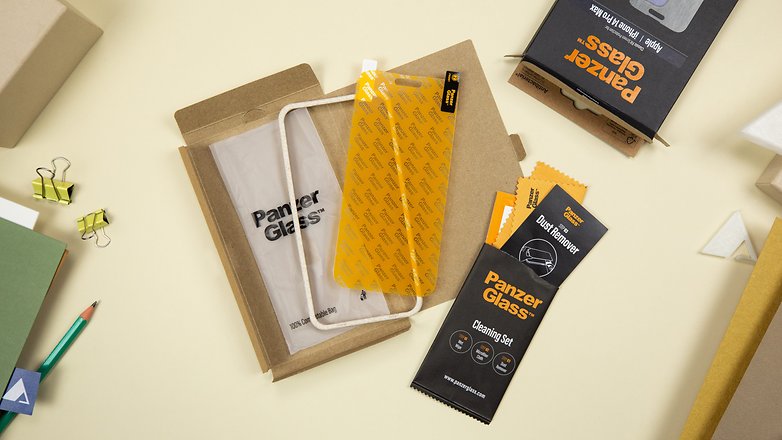Are you looking for a screen protector for your smartphone? Then PanzerGlass™ offers various display protection glasses for the iPhone and various Android smartphones. PanzerGlass™ protective lenses are said to be hyper-strong, shockproof, drop-proof and antibacterial. NextPit was able to test some versions. Here you can read what came of it.
For this occasion I turned into JerryRigEverything and tested different screen protectors for the iPhone 14 Pro Max. I will tell you how strong PanzerGlass™ products are, what you will find in the package besides the protective glass, how easy it is to apply and so on.
a notice: This test was carried out in cooperation with PanzerGlass™. The manufacturer had no influence on the editorial content of this article or the opinion of the author.

The packaging of PanzerGlass™ products aims to be as environmentally friendly as possible. / © NextPit
PanzerGlass™, what is it, who is it?
PanzerGlass™ is a Danish manufacturer that has existed since 2013 and offers cases and screen protection for smartphones, tablets, laptops, smartwatches and other devices. PanzerGlass™ puts a lot of emphasis on the strength of its screen protectors with their four-layer design.
PanzerGlass™ sells its products all over Europe and the different protective glasses are not difficult to find. On average, a PanzerGlass™ screen protector costs around 25 to 30 euros.
From the iPhone 14 (Plus) and iPhone 14 Pro (Max) to the Samsung Galaxy S22 (Plus, Ultra) and Galaxy A53 to the Xiaomi 12 (Pro) and Redmi Note 11 – the most “major” smartphones released since 2019 are covered by the PanzerGlass™ catalogue.
The manufacturer even offers some very special models. There you will find, for example, an anti-spy protective glass that is supposed to prevent others from spying on your smartphone. Other protective glasses are designed to reduce sun reflections outdoors or to filter blue light.

PanzerGlass™ includes an applicator for precise placement. Also, cleaning products are included to prevent dust and fingerprints from getting under the screen protector glass. / © NextPit.
Installing the PanzerGlass™ screen protector
Inside the box, of course, is the screen protector, with a visual cue to tell the front from the back. There is also a cleaning cloth, a small microfiber cloth and a sticker to remove dust and other dirt from the screen. PanzerGlass™ also supplies an applicator to make it easier to apply the screen protector.
The process is pretty quick and easy to do. I’m usually pretty clumsy when it comes to screen protectors and glasses and can never avoid air bubbles. But if you try a little harder than me, you should be fine. On the back of the box you will find a short, illustrated tutorial – and PanzerGlass™ even has a detailed video tutorial on how to apply the protective products on its official youtube channel.
If you mess up the first time, don’t worry: PanzerGlass™ promises you can reapply the same screen protector up to 200 times. I’ve tested it at least 5 or 6 times and I haven’t noticed any loss of adhesion of the surface that comes in contact with the screen. That’s pretty cool and calming.
Incidentally, this works because a full silicone adhesive is used here, which doesn’t really “stick” but works more like a suction cup. This means there are no adhesive residues when you pull it off, and the silicone layer can even compensate for existing scratches.
Firmness/Solidity
PanzerGlass™ offers its screen protection glasses in three levels, from weak to strong: gold, platinum and diamond. I tested a Diamond screen protector, which claims to be the strongest the manufacturer currently sells.
Well, our testing protocol is clearly improvised and a little “shot from the hip” I have to admit. I simply used a hardness tester set with a Moh scale. Included in this kit are pens with tips made from nine different types of minerals. These represent the entire spectrum of Moh’s hardness scale. This spectrum ranges from 2 to 9.
I first scored a screen protector lying flat on a table to determine the first level on the Moh scale at which a scratch could be seen. The first light surface scratches could be seen at level 6. At level 8, I could noticeably scratch the screen protector. But even with force, I could not fully penetrate all layers and would never have reached the smartphone screen.
I also carefully scratched the bare display of the iPhone 14 Pro Max for comparison. Since I want to keep my job and don’t want to be blacklisted by Apple or my boss Fabien, I didn’t dare use the 8 and 9 hardness tips. I therefore left it at levels 6 and 7, which left light scratches on the PanzerGlass™ protective glass – the iPhone screen remained (fortunately) intact. While the material is quite scratch-resistant, it is not quite as stable as the display of the iPhone 14 Pro Max. However, it is also much easier to change the protective glass.
I also took it to extremes and dropped an extremely hard and heavy steel cube from about 30 centimeters onto an LG V40 ThinQ (I really didn’t want to try that with the iPhone 14 Pro Max).
The display isn’t broken, but it has a few dead pixels where it hit the ground. In view of the violent impact, however, that’s no wonder – the physical limits have simply been reached somewhere.

The LG smartphone sustained minor pixel damage from the heavy impact. / © NextPit
A PanzerGlass™ screen protector consists of four layers. Each layer has an individual task. The outer layer is greaseproof. It’s specially treated to resist fingerprints and smudges, ensuring the screen stays readable at all times. According to the manufacturer, the additional antibacterial coating also eliminates up to 99.99 percent of standard bacteria.
Underneath this layer is a 0.4 millimeter thick layer of tempered glass. It protects the screen from direct impact or scratches. Underneath this is a layer of plastic that, like the film on a windshield, holds the glass of your screen together and prevents individual glass particles from scattering in the event of a break. If your smartphone somehow suffers a screen crack due to a fall, this layer also prevents it from expanding further or even splintering. The last layer consists of that special silicone material that we have already described above.
Special protective glasses for more privacy, against reflections and against blue light, …
In addition to the classic display protection glasses, PanzerGlass™ also offers more special models. For this test, for example, I received protection of the “Privacy” type. Basically, this protective glass works in a similar way to the coatings on the screens in some cars, which prevent the driver from watching a film while the passenger can watch the content in peace. If you look at your smartphone from the front, you see everything quite normally. On the other hand, viewed from the side or from above, the screen appears darker or even completely black.
The idea behind this is to protect your screen from prying eyes. I have found that this works very well. But in some situations such protection can also be annoying – for example, if you want to take pictures at a concert far overhead.
Another special protection is the anti-reflective version. According to the manufacturer, it should deflect the reflections of the sunlight so that the screen of your smartphone remains readable when you are outdoors. I tried aiming our strongest video light, which normally illuminates NextPit editors in videos, directly at the iPhone’s screen.
But I didn’t notice a big difference between the iPhone with and without a protective case. Is this because the iPhone 14 Pro Max is the best smartphone ever made? Maybe no light, even from the sky, can cloud the Apple user experience (just kidding, put away your pitchforks).
The last special protection we received is a screen protector glass with an integrated blue light filter. It is designed to dampen or ideally filter out the blue light emitted by our screens that affects our sleep or even supposedly ages our skin. More and more smartphone manufacturers are offering reading modes and anti-blue light filters on their smartphones.
Does that really work? Unfortunately, we couldn’t test it – but we don’t have the right tools to scientifically measure the difference either.
Conclusion
In terms of price, PanzerGlass™ is no more expensive than other manufacturers in this segment. I think that 30 euros for a screen protector that you can reinstall 200 times is absolutely fair. The selection of different protective glasses is also very extensive. There are special protective glasses with sliding elements to cover the selfie camera, protective glasses only for the photo module on the back, and of course protective covers for the sides and so on.
The covers appear to be very sturdy and our iPhone 14 Pro Max survived the test unscathed. The installation is easy and is well explained by the manufacturer. And most importantly, the various protective glasses did not affect the image quality of the display. And even if some screen protectors cover the front camera: I didn’t notice any loss of quality in my selfies.
It’s also nice that PanzerGlass™ offers protective cases for Android smartphones and not only for iPhones. I really like the variety of supported brands and models.
Tag: iphone design, iphone 14, apple iphone, iphone release